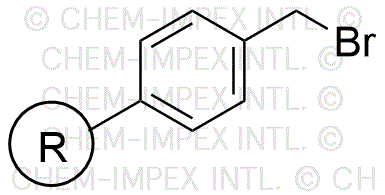Bromomethyl resin is widely utilized in research focused on:
- Organic Synthesis: This resin serves as a versatile reagent in organic synthesis, enabling the introduction of bromomethyl groups into various organic compounds, which is essential for creating complex molecules in pharmaceutical development.
- Polymer Chemistry: It is used in the modification of polymers, enhancing their properties such as adhesion, thermal stability, and chemical resistance, making it valuable in the production of high-performance materials.
- Drug Delivery Systems: The resin can be incorporated into drug delivery formulations, allowing for controlled release of therapeutic agents, which improves the efficacy and safety of medications.
- Surface Functionalization: It is employed in surface modification processes to improve the functionality of materials, such as increasing hydrophilicity or hydrophobicity, which is crucial in biomedical applications.
- Catalysis: Bromomethyl resin can act as a support for catalysts, facilitating various chemical reactions while providing a stable platform, thus enhancing reaction efficiency and selectivity in industrial processes.
General Information
Properties
Safety and Regulations
Applications
Bromomethyl resin is widely utilized in research focused on:
- Organic Synthesis: This resin serves as a versatile reagent in organic synthesis, enabling the introduction of bromomethyl groups into various organic compounds, which is essential for creating complex molecules in pharmaceutical development.
- Polymer Chemistry: It is used in the modification of polymers, enhancing their properties such as adhesion, thermal stability, and chemical resistance, making it valuable in the production of high-performance materials.
- Drug Delivery Systems: The resin can be incorporated into drug delivery formulations, allowing for controlled release of therapeutic agents, which improves the efficacy and safety of medications.
- Surface Functionalization: It is employed in surface modification processes to improve the functionality of materials, such as increasing hydrophilicity or hydrophobicity, which is crucial in biomedical applications.
- Catalysis: Bromomethyl resin can act as a support for catalysts, facilitating various chemical reactions while providing a stable platform, thus enhancing reaction efficiency and selectivity in industrial processes.
Documents
Safety Data Sheets (SDS)
The SDS provides comprehensive safety information on handling, storage, and disposal of the product.
Product Specification (PS)
The PS provides a comprehensive breakdown of the product’s properties, including chemical composition, physical state, purity, and storage requirements. It also details acceptable quality ranges and the product's intended applications.
Certificates of Analysis (COA)
Search for Certificates of Analysis (COA) by entering the products Lot Number. Lot and Batch Numbers can be found on a product’s label following the words ‘Lot’ or ‘Batch’.
*Catalog Number
*Lot Number
Certificates Of Origin (COO)
This COO confirms the country where the product was manufactured, and also details the materials and components used in it and whether it is derived from natural, synthetic, or other specific sources. This certificate may be required for customs, trade, and regulatory compliance.
*Catalog Number
*Lot Number
Safety Data Sheets (SDS)
The SDS provides comprehensive safety information on handling, storage, and disposal of the product.
DownloadProduct Specification (PS)
The PS provides a comprehensive breakdown of the product’s properties, including chemical composition, physical state, purity, and storage requirements. It also details acceptable quality ranges and the product's intended applications.
DownloadCertificates of Analysis (COA)
Search for Certificates of Analysis (COA) by entering the products Lot Number. Lot and Batch Numbers can be found on a product’s label following the words ‘Lot’ or ‘Batch’.
*Catalog Number
*Lot Number
Certificates Of Origin (COO)
This COO confirms the country where the product was manufactured, and also details the materials and components used in it and whether it is derived from natural, synthetic, or other specific sources. This certificate may be required for customs, trade, and regulatory compliance.


